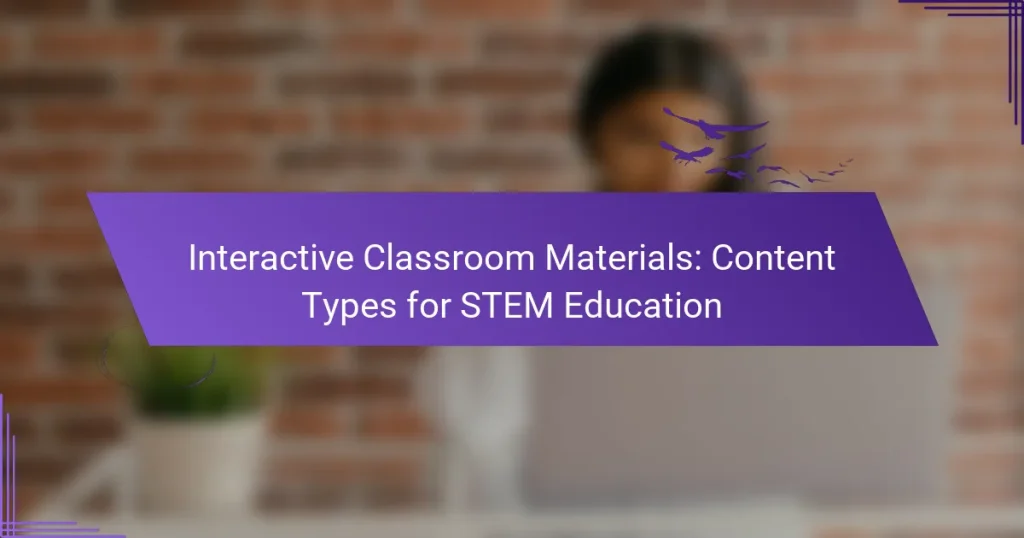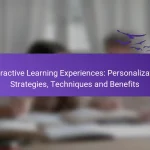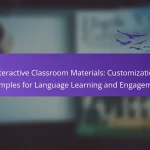Interactive classroom materials play a crucial role in STEM education by fostering hands-on learning and collaboration among students. By transforming traditional learning into dynamic and participatory experiences, these resources enhance understanding and retention of complex concepts. Digital tools further amplify engagement, providing opportunities for real-time feedback and exploration, making STEM subjects more accessible and enjoyable.

What are effective interactive classroom materials for STEM education?
Effective interactive classroom materials for STEM education engage students through hands-on learning and collaborative experiences. These materials can enhance understanding and retention of complex concepts by making learning dynamic and participatory.
Digital simulations
Digital simulations replicate real-world processes and systems, allowing students to experiment without the constraints of physical resources. They can visualize scientific phenomena, manipulate variables, and observe outcomes in a controlled environment.
For example, platforms like PhET offer simulations for physics and chemistry that enable learners to explore concepts like motion or chemical reactions interactively. Consider integrating these tools into lessons to foster deeper comprehension.
Hands-on experiments
Hands-on experiments provide students with tangible experiences that reinforce theoretical knowledge. These activities often involve using common materials to conduct experiments, making them accessible and engaging.
For instance, building simple circuits with batteries and bulbs can help students grasp electrical concepts. Ensure safety guidelines are followed, and provide clear instructions to maximize learning outcomes.
Collaborative projects
Collaborative projects encourage teamwork and problem-solving skills while allowing students to apply STEM concepts in real-world contexts. These projects can range from designing a bridge to creating a sustainable garden.
To implement effective collaborative projects, set clear objectives and roles for each group member. This structure helps maintain focus and ensures that all participants contribute meaningfully to the project.
Interactive quizzes
Interactive quizzes assess student understanding in an engaging way, providing immediate feedback that can guide further learning. Tools like Kahoot! or Quizizz allow for real-time participation and can be tailored to various topics in STEM.
Incorporate quizzes regularly to reinforce concepts and identify areas needing review. Aim for a mix of question types, including multiple-choice and true/false, to keep students engaged and challenged.
Augmented reality applications
Augmented reality (AR) applications enhance the learning experience by overlaying digital information onto the physical world. This technology can bring abstract STEM concepts to life, making them more relatable and easier to understand.
For example, AR apps can allow students to visualize molecular structures or explore the solar system interactively. When selecting AR tools, ensure they align with educational goals and are user-friendly for students.
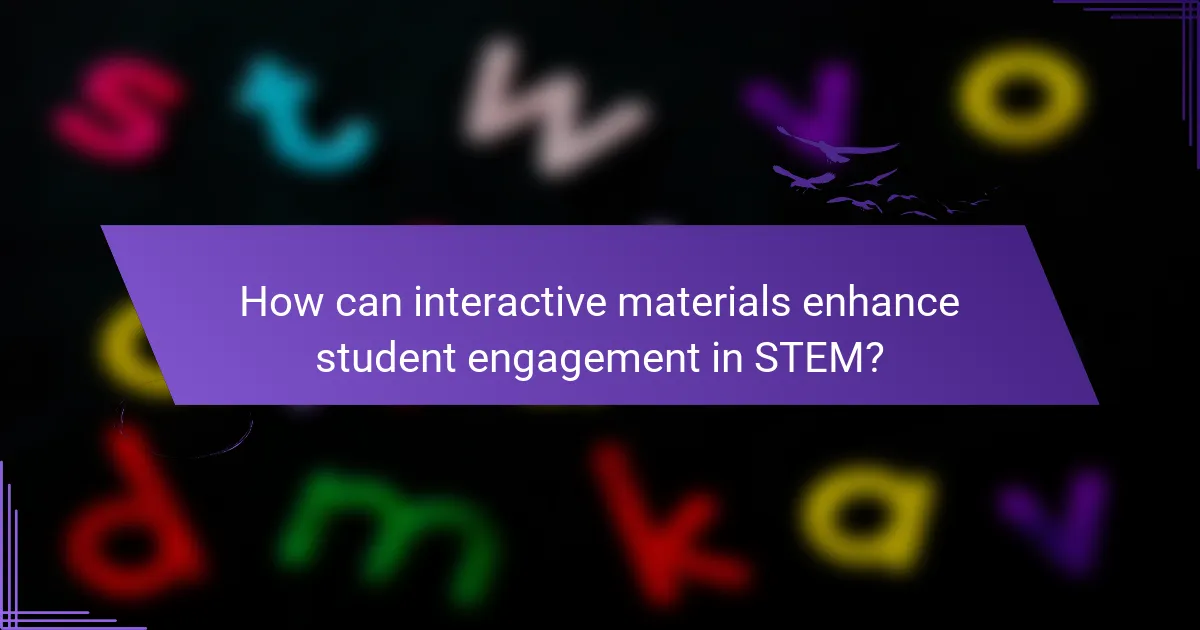
How can interactive materials enhance student engagement in STEM?
Interactive materials significantly boost student engagement in STEM by making learning more dynamic and participative. These resources encourage hands-on experiences, allowing students to explore concepts actively rather than passively absorbing information.
Promotes active learning
Active learning through interactive materials involves students directly in the learning process, enhancing retention and understanding. Techniques such as simulations, experiments, and problem-based learning require students to apply concepts in real-time, which deepens their comprehension.
For example, using virtual labs allows students to conduct experiments that would be difficult or unsafe in a traditional classroom. This hands-on approach can lead to increased motivation and a stronger grasp of complex STEM topics.
Encourages collaboration
Interactive materials foster collaboration among students, promoting teamwork and communication skills essential for STEM fields. Group activities, such as coding challenges or engineering projects, encourage students to share ideas and solve problems collectively.
Incorporating tools like online discussion boards or collaborative software can enhance this experience, allowing students to work together regardless of their physical location. This not only builds social skills but also prepares them for future collaborative work environments.
Facilitates real-world applications
Interactive materials help students connect theoretical knowledge to real-world applications, making learning more relevant and impactful. By engaging with simulations and case studies, students can see how STEM concepts apply to everyday problems and industries.
For instance, using data analysis tools to interpret real datasets can illustrate the importance of statistics in fields like healthcare or environmental science. This practical approach not only enhances interest but also equips students with skills they can use in their future careers.
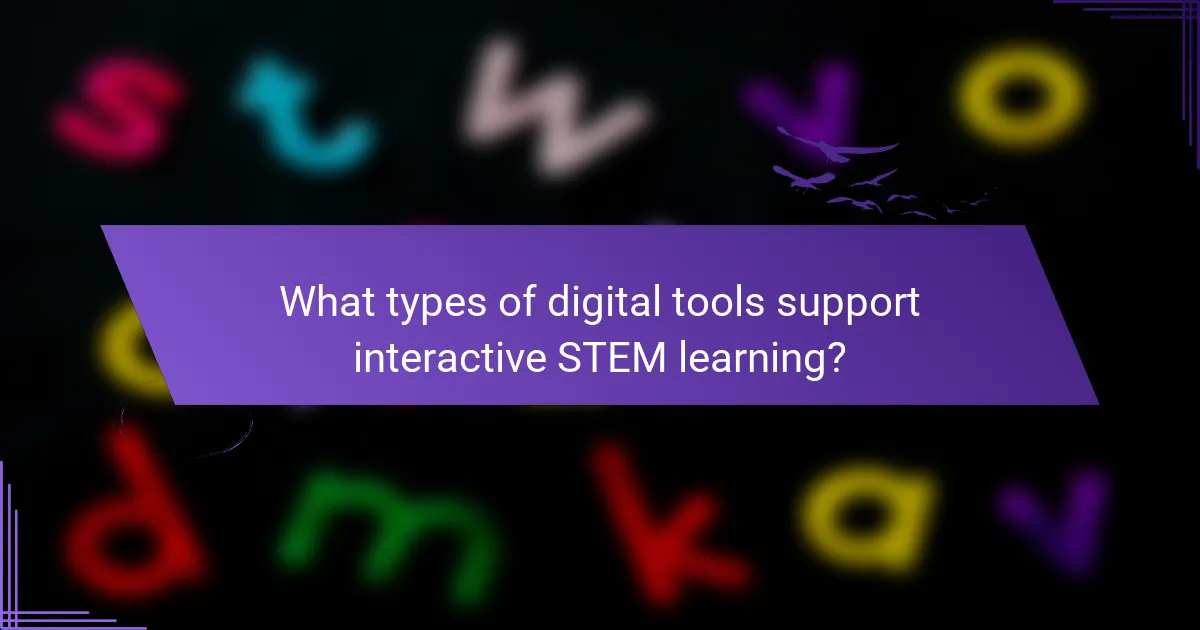
What types of digital tools support interactive STEM learning?
Digital tools for interactive STEM learning enhance student engagement and comprehension through various formats. These tools facilitate collaboration, real-time feedback, and hands-on experiences, making complex concepts more accessible and enjoyable.
Kahoot!
Kahoot! is a game-based learning platform that allows educators to create quizzes and interactive games. Students can participate using their devices, answering questions in real-time, which fosters a competitive yet fun learning environment.
To effectively use Kahoot!, teachers should design quizzes that align with their curriculum and encourage discussion. Keep quizzes short, ideally between 10 to 20 questions, to maintain student interest and focus.
Nearpod
Nearpod is an interactive presentation tool that combines slides with real-time assessments and activities. Teachers can create lessons that include polls, quizzes, and virtual reality experiences, allowing for a more immersive learning experience.
When using Nearpod, consider integrating multimedia elements to cater to different learning styles. Aim for lessons that last about 30 to 45 minutes to keep students engaged without overwhelming them.
Google Classroom
Google Classroom is a free platform that streamlines assignment distribution and communication between teachers and students. It allows educators to organize resources, share materials, and provide feedback efficiently.
To maximize Google Classroom’s potential, regularly update assignments and use its integration with other Google tools like Docs and Sheets. Encourage students to collaborate on group projects within the platform to enhance teamwork skills.

What are the benefits of using hands-on experiments in STEM?
Hands-on experiments in STEM education enhance learning by providing practical experience that reinforces theoretical concepts. These activities engage students actively, making complex ideas more accessible and memorable.
Improves retention
Hands-on experiments significantly boost retention by allowing students to physically engage with the material. When learners participate in experiments, they are more likely to remember the concepts associated with those activities.
For example, students who conduct experiments on chemical reactions can recall the processes better than those who only read about them. This experiential learning approach can increase retention rates by a notable margin, often seen in educational settings.
Encourages critical thinking
Engaging in hands-on experiments fosters critical thinking skills as students must analyze results, troubleshoot issues, and make decisions based on their observations. This process encourages them to question assumptions and explore alternative solutions.
For instance, when students design their experiments, they learn to formulate hypotheses and evaluate outcomes, enhancing their analytical abilities. This skill set is crucial for future academic and professional endeavors in STEM fields.
Fosters creativity
Hands-on experiments provide a platform for creativity, allowing students to explore innovative approaches to problem-solving. When students are encouraged to design their experiments, they can think outside the box and apply their unique perspectives.
For example, a project on renewable energy might allow students to create their wind turbines using various materials, promoting inventive thinking. This creative exploration not only makes learning enjoyable but also prepares students for real-world challenges in STEM careers.

What criteria should educators consider when selecting interactive materials?
Educators should prioritize criteria such as alignment with curriculum standards and accessibility for all students when selecting interactive materials. These factors ensure that the resources effectively support learning objectives and are usable by a diverse range of learners.
Alignment with curriculum standards
Interactive materials must align with established curriculum standards to ensure they meet educational goals. This alignment helps educators integrate these resources seamlessly into their lesson plans, enhancing the overall learning experience.
When evaluating materials, check if they correspond to local or national standards, such as the Next Generation Science Standards (NGSS) in the U.S. or the National Curriculum in the U.K. Consider using a checklist to verify alignment, focusing on key concepts and skills outlined in the standards.
Accessibility for all students
Accessibility is crucial for ensuring that all students can engage with interactive materials. Resources should accommodate various learning styles and needs, including those of students with disabilities.
Look for materials that offer features like text-to-speech, adjustable font sizes, and alternative formats. Additionally, consider the usability of the technology itself; it should be easy to navigate for students of all abilities. Providing training for both educators and students on how to use these tools can further enhance accessibility.
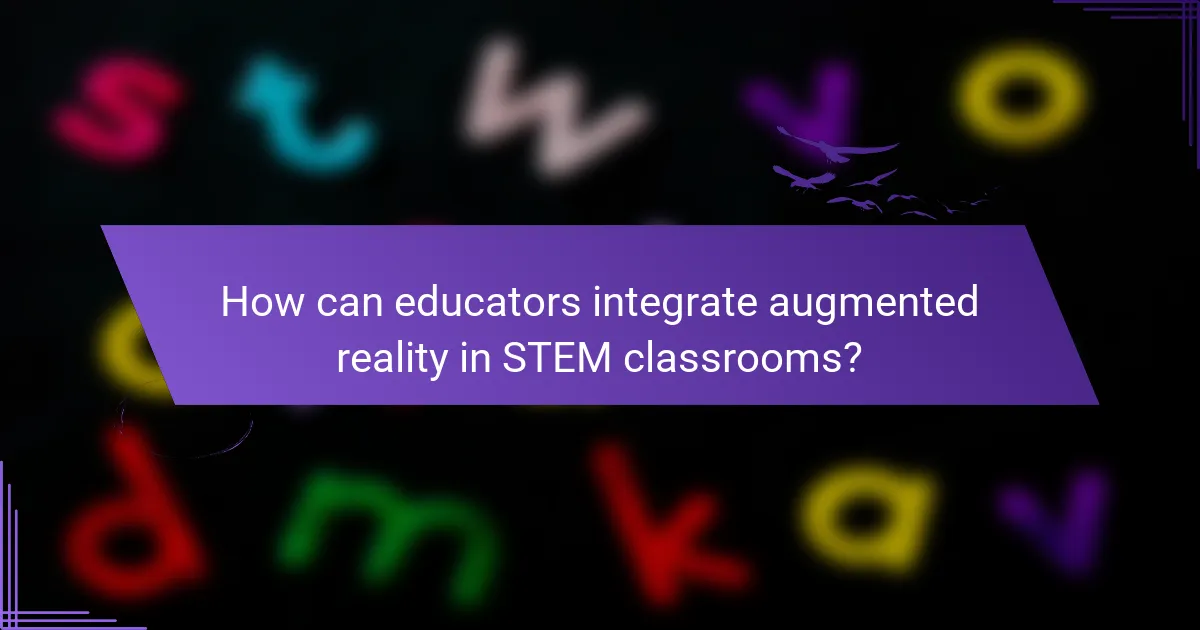
How can educators integrate augmented reality in STEM classrooms?
Educators can integrate augmented reality (AR) in STEM classrooms by utilizing AR applications and tools that enhance interactive learning experiences. These technologies allow students to visualize complex concepts and engage with content in a dynamic way.
Benefits of using augmented reality in STEM education
Augmented reality offers numerous benefits in STEM education, including increased engagement, improved understanding of abstract concepts, and enhanced collaboration among students. By providing immersive experiences, AR can make learning more appealing and memorable.
For example, students can explore the human body in 3D or manipulate molecular structures, which can lead to deeper comprehension. Additionally, AR can facilitate group projects, allowing students to work together on virtual simulations.
Tools and applications for augmented reality
There are various tools and applications available for educators to implement AR in their classrooms. Popular options include platforms like Merge Cube, Google Expeditions, and AR Flashcards, which provide interactive content tailored for STEM subjects.
When selecting AR tools, consider factors such as ease of use, compatibility with existing devices, and the quality of educational content. Many applications are free or low-cost, making them accessible for diverse educational settings.
Implementation strategies for educators
To effectively implement augmented reality in STEM classrooms, educators should start by identifying specific learning objectives and selecting appropriate AR resources that align with those goals. Planning lessons that incorporate AR should focus on hands-on activities that encourage exploration and inquiry.
Additionally, educators should provide clear instructions and support for students as they navigate AR experiences. Regularly assessing student engagement and understanding can help refine the use of AR tools for future lessons.
